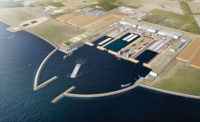During the past four years, as millions of New York City subway commuters daily made their way through the transit system, tunnelers below were making history. In 2009, for the first time ever, tunnel-boring machines burrowed through ground that was artificially frozen, with crews placing precast segments in the TBMs’ wake. The twin tunnels form a 1.5-mile extension of the No. 7 subway line, from Manhattan’s Times Square station to the far West Side.
For the most part, the TBMs dug through bedrock up to about 100 ft deep. But in one 300-ft-long segment, the top of the rock layer dips, which meant tunnelers had to dig through a mix of hard rock and soft soils in that stretch.
Just as a hand drill would gravitate toward wood instead of steel to take the path of least resistance, so a TBM would want to move toward the soft soil, says Shawn Kildare, the Metropolitan Transportation Authority Capital Construction program executive for the $2.1-billion project. “By freezing the ground, you make the substances uniform and control water filtration.”
The joint venture S3II—comprising J.F. Shea Construction, Walnut, Calif.; Skanska Civil, New York City; and Schiavone Construction, Secaucus, N.J.—decided to freeze the section and run the TBM through it non-stop. “Nobody had ever run a TBM through frozen ground before,” says Gary Almeraris, Skanska project executive.
Crews built three freeze plants and drilled pipes made of aluminum and steel 140 ft deep—five feet below the future tunnel floor. Pipes within the pipes carried calcium chloride brine, frozen to -25°C, into the ground. “We had a block of frozen ground completely through the alignment, with thick walls on either side and a crown above,” says Almeraris.
One at a time, each TBM mined through the section, including the now-empty pipes, in summer 2009. Then, precast tunnel-liner segments were grouted into place. “Even placing segments in a rock tunnel, we had never done that before,” says Kildare.
Even the grout couldn’t be taken for granted. “One of the major considerations was whether the grout would set properly in the frozen ground,” says Christopher Allen, construction manager with the Hill International, HDR Inc. and LiRo joint venture that serves as the MTACC’s construction manager. “We played with a lot of components of the mix.”
Preparatory work was key. Months before the TBMs arrived, the contractor built a substation just to power them and negotiated with the power utility. The 22.5-ft-dia TBMs, each as long as 460 ft with trailing gear, began traveling north out of an assembly chamber at 11th Avenue and 26th Street. A series of conveyor belts transported all 140,000 cu yd of muck to a small pit, which 30 trucks emptied.
At 34th Street, a 1,200-ft-long, 60-ft-wide cavern already had been drilled and blasted. At 41st Street, the TBMs made a 650-ft-radius, or 90°, turn, heading east toward the Times Square station. The route crosses beneath the tubes of the Lincoln Tunnel, Amtrak and four tracks of the Eighth Avenue subway line. Crews had to underpin the subway tracks while keeping them in service as well as lower the tail tracks of the existing No. 7 line by about eight feet to link with the extension, says Kildare.
A total of 10 columns supporting the subway line were underpinned at night, says Kildare. “Loads were transferred at night while still maintaining Eighth Avenue subway operations.”
The extension also passes beneath the Port Authority of New York and New Jersey’s Bus Terminal, and crews had to drill and blast 6,000 cu yd of rock in the terminal’s lower level to make room. “We put a deck over the area, and the port authority continued its operations, 24 hours a day,” says Kildare. People continued to board buses just feet away from the drilling and blasting. Originally, the work was to be done only at night, but the port authority allowed 24-hour access, and that shaved off almost two years from that portion of the project.
By the time the tracks of the new extension terminate in Times Square, they are only about four feet apart. Because the TBMs grip the rock to move forward, the last 210 ft of rock was reinforced with fiberglass rock bolts and steel pilings.
Now in the home stretch of its $1.2-billion contract, the S3II team is building the permanent structures for the 34th Street station. Concrete station arches are being built in 350-cu-yd pours, and the team is completing six cross passages to connect to the two main tunnels. S3II stands to earn as much as $300,000 in bonuses for completing the job well ahead of its September deadline. “Ninety percent of the challenges have been overcome,” says Kildare.
Two of three follow-on contracts have been awarded—one for a $57-million building housing ventilation and substation facilities, and one for $116 million to build support structures and the main entrance at the 34th Street station, says Peter Wahl, project manager with Parsons Brinckerhoff, New York City, the project designer. A third contract to build another ventilation facility will require replacing an existing road viaduct, he adds. A systems and finishes contract will be awarded later this year.
Even the simple structures, such as the fan plants, are challenging because developers are constructing new buildings in the recently rezoned area. The extension’s facilities have to be incorporated into the new buildings, which have caissons that snake down and around the new subway line. But thanks to that same development, the subway is expected to carry almost 20,000 passengers per peak hour by 2025.








Post a comment to this article
Report Abusive Comment